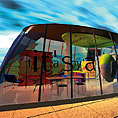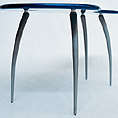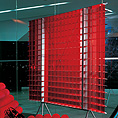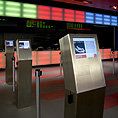











The Superdimension FridgeSDF-1The Superdimension Fridge is a bar refrigerator, opening vertically by internal air ram and cooled by air rather than fluro carbons. In this piece I was interested in challenging the tyranny of 'white goods' aesthetic and traditional definitions of when is a domestic utensil a piece of furniture (and subject to the cultural baggage of design ) and when is it a mysterious and authoritive machine (not to be tampered with) This refrigerator while being radically different in form and intended to be aesthetically pleasing also plays on the idea of drinking around the bar (the external rings are at elbow height and could be lent on) quietly sending up the Australian culture of drinking as a social focus. |
The refrigerator opens vertically and therefore conserves its coldness-somewhat reducing energy consumption (avoiding the cold loss and moisture gain from a front opening door) In generating the shape I was looking for new forms coming from a contemporary context- existing technology, not historical references. The refrigerator's form is an expression of it's operation. The mechanism is turned outwards to decorate the fridge incidentally giving much more room inside (the rings are the condenser tubes). These ones are much bigger and more effective. The contents of the refrigerator rise vertically when opened, to an optimal ergonomic height for removal. The Lazy susan shelves spin to allow easy access to all the contents from one point. The cone base contains the compressor (the engineering symbol for compression is a triangle). |
That the finished fridge looks like part of an Apollo space craft is in part due a similar simple use of the required elements to achieve an efficient result unconstrained by the weight of culturally sanctioned design history (also, both are containers that isolate an exotic atmosphere.Apollo can be viewed as an intergalactic gourd, one in a long line of serviceable containers.) |
SDF-1 Refrigeration Project: Notes |
Introduction |
 |
Unfortunately it is fashionable to suggest current practice is primitive and wasteful. The focus of development for the past 60 years has been towards cheap and reliable refrigeration. The fact that the overwhelming majority of western households have at least one refrigerator, and that continuous uninterrupted operation without maintenance for 10 years or more is assumed indicates the state of current technology. |
It is illustrative to note that some of the best minds of the 20th century have worked on the domestic refrigerator. In 1920's Berlin, Albert Einstein and Leo Szilard began work on an electromagnetic refrigeration cycle which they patented and licensed to AEG. Their motives were humanitarian, having read of the unnecessary deaths of an entire Berlin household whose ammonia-filled domestic refrigerator had leaked and suffocated the family, who were asleep in bed. |
The development of an environmentally-sound refrigerator is relatively easy. The development of such a unit which is also as cheap, compact, reliable and safe is an enormous undertaking. |
Assumptions |
The prospects for existing alternatives were no better than they had ever been. Propane and Butane had been widely used in the 20s and 30s, but rightly or wrongly flammability concerns had worked against them. The increased risk of propane or butane refrigerants is likely to small, but so too is the extra risk of death from ozone depletion-induced skin cancer. The prince of non CFC refrigerants is ammonia, widely used in industry. Like methyl chloride and sulphur dioxide, its toxicity is too great to consider using it in domestic applications. |
The only refrigerant that is truly benign where the environment and health are concerned is air. And indeed, it was for these reasons air was widely used to replace ether in refrigeration plant on ships plying the meat trade between Australia and England. When ships sank as a result of burst boilers, or striking of unmarked rocks, without the additional risk of massive explosion and fire, caused by ether leak. The pyrotechnic properties of ether were observed early on by surgeons using it as an anaesthetic, who when cauterizing wounds the red-hot iron pokers, found their patients lungs were also prone to explode. Air is currently the principal refrigerant in aeroplane air-conditioning systems. The principal disadvantage of air refrigeration cycles is their sensitivity to losses. Their high theoretical rate of efficiency is in practice lower than that of vapour compression cycles. Consequently, the cost might also be higher. |
page: 1 | 2 |
2008 © Crowd

